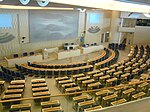User:Glitter/Sandbox2
Comhthionól Náisiúnta | |
|---|---|
 | |
| Type | |
| Type | |
| History | |
| Established | 1857 |
| Disbanded | 2021 |
| Meeting place | |
 | |
| Comhthionól Chamber Carrowdun Palace, Spálgleann | |
The Comhthionól Náisiúnta (literally "National Assembly") was the lower house of the bicameral Tionól of Caldia from 1857 until 2021. It was also the principal chamber. During the bicameral period, the upper house was the Seanad Glaíteann (literally "Senate of Caldia").
The chamber's powers were similar to those of lower houses under many other bicameral parliamentary systems. It became the dominant chamber of the Tionól starting in 1965. It had the power to pass any law it wishes. It was also responsible for nominating nominate and removing the taoiseach, who had to belong to the chamber.
It had 399 members who were directly elected every five years. 200 of its members were elected from multi-member constituencies and the remaining 199 members were elected using a party list proportional method.
The chamber effectively became the unicameral Tionól starting on 12 May 2021.
Origins and history
The Comhthionól was established by the Instrument for Governance Act of 1857, the first major amendment to the 1814 constitution. The legislation came from a movement known as the Silent Revolution, which sought to reform Caldish politics and liberalize society. The need for reforms was identified by Dónall Ó Conaill and his liberal allies, who worried about a popular uprising following similar revolts in Euclea.
The chamber was composed of 400 elected members, who were known as Teachti Comhthionól (TCs). TCs were to be elected from constituencies across the nation under a first-past-the-post system. Two TCs were chosen for each electoral district, with the two candidates receiving the most votes by plurality winning the seat. From its creation in 1857 until 1965, it had the same powers as the Seanad Glaíteann. The chamber had less control over legislation due to the status of the Comhthionól, but did have say over the budget. If the two chambers were in disagreement, issues had to be re-addressed through the submission of a new joint proposal. These proposals were facilitated by standing committees consisting of members from both chambers
In 1965, the number of TCs was reduced from 400 to 399 in order to end the practice of drawing lots when a vote in the chamber ended in a deadlock. The Comhthionól also became the principal chamber as the powers of the Seanad were significantly reduced through the Instrument for Governance of 1965.